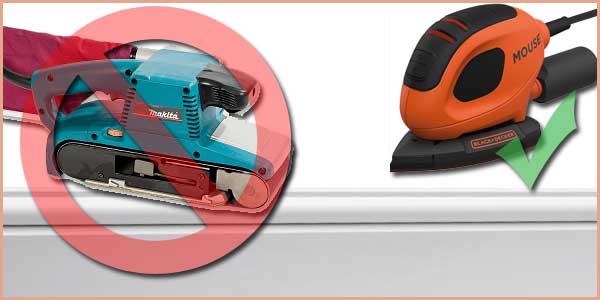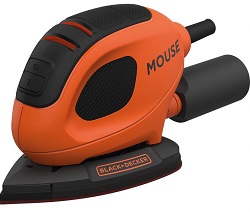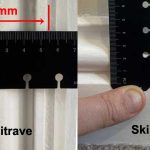If you’re looking to sand skirting boards and repaint, then you may be considering the best way of doing this. One option, is to use an electric sander. However, there are several different types of sander on the market, and not every type is suitable for this type of work.
In most cases, the best type of sander for skirting board will be a detail sander. If you don’t have a dentil sander, a small orbital sander will do a similar job. Both will make it easier to sand every part of the skirting boards face and moulding.

A belt sander will not be a good choice for this job, and this is for a few reasons.
- Belt sanders are slightly more aggressive – This means you can easily take off too much and cause uneven areas on the board. As well as ruining the moulding.
- It won’t reach all the way to the floor – The body of a belt sander is often wider than the belt, which means it wont sand the bottom of the skirting.
- A belt sander won’t get into the moulding – Unless you are using a straight, relatively flat skirting board, such as pencil round, you will struggle to sand the entire board with a belt sander. Something like Ogee, or Torus will be near impossible to sand this way. Whats more, if you try, there is a very real risk that you will ruin the shape.
The advantage with a smaller sander, is they sand the paint in a more circular motion, which is less aggressive and more even. It is also much easier to sand into the moulding and reach every part of the skirting board.
Good affordable sander for skirting boards
There are many brands to choose from, and if you are a professional that will be using this regularly, then you can certainly pay more for bigger brands like DeWalt and Makita. This may even be necessary if you require 110v.
However, if you just need a sander for DIY jobs, you can get a decent detail sander for £20-£30.

Our favourite budget option, is the Black and Decker 55W Mouse.
This is a great little tool for this job, and it is very affordable. The sander comes with 6 free sanding sheets, these stick to the pad with a hook and loop design (similar to Velcro). This makes them very easy to add and remove.
It has rubber grips which combined with the shape and its light weight, all make it easy and comfortable to hold and use.
Due to the tear drop pads shape, it is very good for getting into tight gaps. Obviously, this is very helpful for things like skirting and architrave, where you need to get right into the moulding.
Finally, it has a handy extraction port, which makes it easy to connect to a vacuum cleaner. This massively reduces the amount of dust that is created.
Overall, for the price, this is a great tool for this type of job.
To learn more about the Black and Decker 55W Mouse, and read a tonne of customer reviews Click Here
Sandpaper vs electric sander for skirting boards
Whilst an electric sander is a good option. In many cases, sanding manually will be sufficient.
Unless your skirting boards have thick layers of paint, that has built up over years, they will often only need a light sand. If you are just tidying them up, then you just need to provide a good surface for new paint.
In order to achieve this, your goal should be to remove the shiny gloss surface on the skirting boards. This will leave a smooth, lightly scratched surface, that will provide a good key for a new coat of paint.
This can be achieved manually with some 120-grit sandpaper.
The advantage of using an electric sander here is quite simple. It will require less physical effort and it will be slightly quicker. The main disadvantage, is you are likely to create more dust with an electric sander.
However, as we mentioned previously, a sander like the Black and Decker 55W Mouse, can easily be attached to a vacuum. By doing this, you will significantly reduce the issue of dust.
Depending on the size of the job, you may benefit from using a combination of electric sander, and sandpaper.
Removing thick layers of paint
Whilst sandpaper and a detail sander will be sufficient in most cases. There are times when skirting has many layers of paint, that have been added over years. At some point, this can start to look really unpleasant, so you may want to completely remove the paint and start again.
If this is the case, then sanding might not be the best option. Sanding thick layers of paint will take far longer, it will create much more mess, and you will go through a lot of sanding pads as they clog up with paint.
If you find yourself in this position, you have a couple of options.
- Use a heat gun and a scraper – This is a great method and actually quite satisfying. The heat gun warms up and softens the paint, making it lose its grip on the skirting boards. Following this, the paint can be easily scraped off the surface, exposing the bare skirting below.
Again, Black and Decker do a really good/affordable paint stripper. You can learn more about that by Clicking Here - Remove the skirting boards – This is a less popular option, but in some cases it can be quicker and easier to just replace old skirting with nice new boards. This does save the hassle of stripping and sanding, but you will have some extra work fitting the skirting boards.
Also, if you need to remove skirting boards, but you intend to add them back, you could sand them whilst they are off the wall. This is one occasion where a belt sander may actually come in handy. Long lengths could be sanded on the face with a belt sander and then all the little grooves and details can be done by hand, or with a detail sander.
Conclusion
If you intend to use an electric sander, then a small detail sander is the best type of sander for skirting board. If you don’t have a detail sander, then a small round or square orbital sander will do a similar job. However, it might not get into some of the tighter areas.
As we mentioned previously, if you are interested in an affordable, good quality detail sander, we do recommend the Black and Decker 55W Mouse.
Also if you are happy to put in a bit of elbow grease, smaller jobs can be done manually with sandpaper.
For thicker and more stubborn paint removal, sanding is probably not your best option. A better method in this scenario, is using a heat gun and a scraper to remove the bulk of the paint. Following this, you can finish the job off by sanding.




